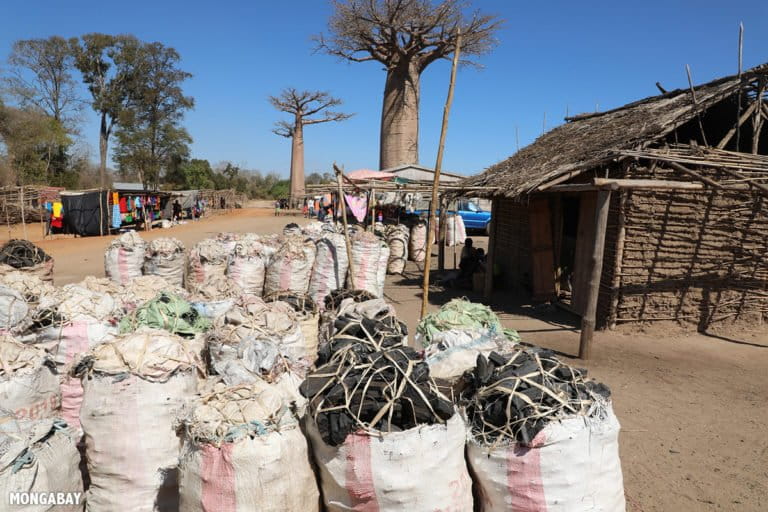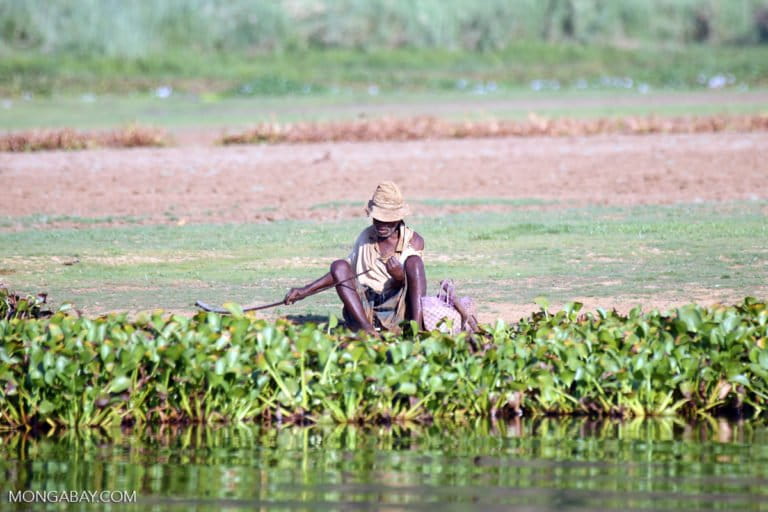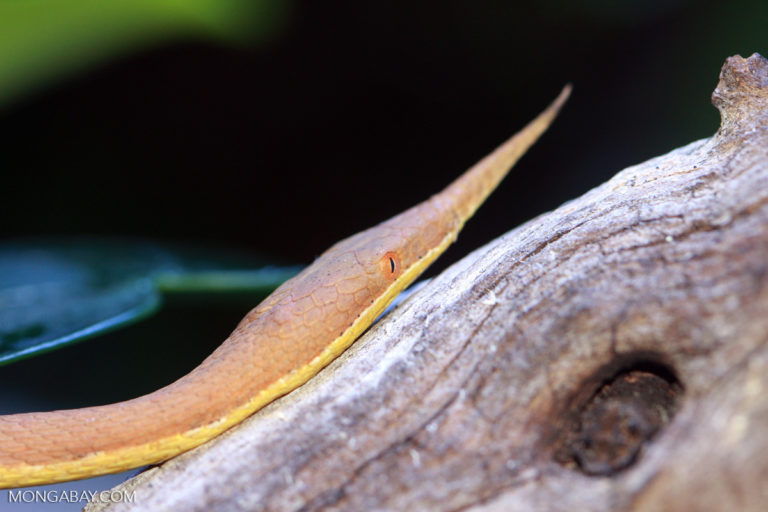- Madagascar’s environment minister has criticized the way protected areas are managed in the country, setting the stage for a potential overhaul of the system to make conservation more people-centric.
- The stand has flustered some in the conservation community in Madagascar because it could mean reorienting their efforts in one of the planet’s most biodiverse countries, which is also extremely poor with high rates of environmental destruction.
- At a two-day meeting in late June, protected area managers, including a quasi-governmental agency and several international and local NGOs, shared details of their work, financial position, and challenges, with ministry officials.
- The ministry is expected to collate and analyze this information as a first step toward a broader evaluation and potential overhaul of the protected area system that could happen this year.
ANTANANARIVO, Madagascar — Madagascar’s protected area network has failed to improve the lives of people, the country’s environment minister observed at a recent meeting, setting the stage for an overhaul of how protected areas are managed.
“The conservation of our biodiversity through Madagascar protected areas’ system for 30 years was a failure,” Baomiavotse Vahinala Raharinirina said at a meeting earlier this year. “We have to change the paradigm and to move toward a system which doesn’t exclude humans and [doesn’t] put local communities on the sidelines; it should be deeply social.”
She was addressing a two-day meeting held in late June with the country’s protected areas’ managers in the capital Antananarivo. The stance has flustered some in Madagascar’s conservation community because it could mean reorienting beleaguered conservation efforts in one of the planet’s most biodiverse countries.
Protected areas (PAs) are one of the only lines of defense against runaway environmental destruction in the island nation. In 2003, Madagascar’s then-president, Marc Ravalomanana, committed to tripling the network’s extent, from just under 2 million to 6 million hectares (4.9 million to 14.8 million acres), under the Durban Vision. It would prove to be a backbreaking undertaking for a country where a majority of the 26 million inhabitants live on less than $1.90 a day. More than half live in rural areas and rely heavily on forests for food, fuel and building materials.
“Neither the ministry in charge of ecosystem management, nor colleagues from various organizations working for conservation, are able to effectively address the issues of PA governance, given that the problem is complex,” Raharinirina told Mongabay.

Madagascar’s protected area network includes 144 parks, of which the ministry of environment and forests directly manages only 15. Of the rest, a quasi-governmental organization called Madagascar National Parks (MNP) manages 46, and nongovernmental organizations, both domestic and foreign, oversee 92. These efforts are primarily supported by international donors, who play an outsized role in the country’s endeavor to safeguard its natural riches.
Observers often criticize the quality of the protection endowed by the parks because deforestation has persisted in Madagascar at alarming levels, including inside park boundaries. In 2018, the country lost the largest proportion of primary tropical forests anywhere in the world. A recent IUCN update noted that a third of Madagascar’s iconic lemur species are one step away from extinction.
But the minister’s bleak assessment does not appear to be prompted solely by the poor record on deforestation and threats to the country’s unique biodiversity. “It is not fair to see small villages near the country’s most important tourist destinations, where people continue to live in darkness and [with] poor drinking water,” she said.

The minister’s comments suggest that the goalposts for a successful protection strategy could be moved to emphasize a people-centric approach. “Our vision is the effective implementation of conservation, that is a strengthened, even systematic consideration of community, then local and regional development in conservation actions,” Raharinirina said.
Conservationists defend their work but acknowledge there is a problem. “It seems like they are blaming us, [but] if we are not here the biodiversity will have been long gone,” primatologist and conservationist Jonah Ratsimbazafy said. He said the message he took away from the meeting was: “We have to demonstrate that conservation can help people.”
Some conservationists, including Ratsimbazafy, believe the ministry is responding to pressure from lawmakers in the country, members of parliament, who tend to look at conservation as essentially “anti-economic.”
The environment ministry is seeking to prioritize the protected areas’ economic potential. “Never forget that 12% of our GDP is ensured by the tourism sector, but 80% of these tourists come to Madagascar for our protected areas,” Raharinirina said at the June meeting.
But some managers feel they are being unfairly put on the spot for entrenched problems that arise from factors beyond their ambit, and sometimes control. “The poverty had been there before the flurry of conservation and development activity throughout the creation of new protected areas in the early 1990s,” said Lily-Arison René de Roland, national director for Peregrine Fund Madagascar, which manages four conservation areas in the country. “It is unfounded to assert that the existence of the protected areas implies poverty.”

Many protected area managers work with local communities to ease pressure on forests, wildlife, and marine ecosystems. Some of these efforts also contribute to people’s livelihoods. While the debate is often couched as “environment versus development,” increasingly practitioners around the world see protecting livelihoods as an integral part of conservation projects. A study that looked at a welfare program in Indonesia concluded that reducing poverty and protecting forests are not “mutually exclusive goals.”
The Tsimembo Manambolomaty complex, one of the sites the Peregrine Fund runs, is a 62,745-hectare (155,046-acre) stretch of land on Madagascar’s western coast. It includes dense, dry forests, mangroves and lakes. “Local fishers annually catch around 300 tons of fresh fish, which generate 800 million ariary [about $209,000] for the neighboring communities, apart from taxes for the local administration, and [provide] vital ecosystem services such as carbon sequestration,” René de Roland said. “Such profits would have been disappearing for years if we hadn’t protected the existing natural resources.”

While many park managers agree they have a role in alleviating hardship for local people, they are reluctant to take responsibility for it. “We are asked to construct roads, build schools, hospitals, and provide the community with health care … nonetheless, this is not our specialty,” said Mamy Rakotoarijaona, director-general of MNP.
Several managers echoed Rakotoarijaona’s view that conservation-focused NGOs’ main draw to work in these areas is preserving biodiversity. Protected areas in Madagascar have attracted scientists of all hues who are often pulled into management roles under the aegis of conservation.
At the two-day workshop in June, park managers gave presentations on their work, their financial position, and the challenges they faced on the ground. The minister said the presentations revealed that “a majority of these colleagues do not have the required skills regarding community development, and our regulations as regards PA management are not sufficiently binding as far as concerns communities’ livelihood improvement.”

Conservationists frequently point to ecotourism as a way for communities to benefit from safeguarding biodiversity, and it has shown some promise. Tapping into the tourism potential, however, requires more than safeguarding the ecosystems and their wildlife. Nosivolo is a riverine Ramsar site home to 19 endemic fish species in the western district of Marolambo. It has the potential to attract local and international visitors. However, bad roads and the absence of infrastructure have dimmed its prospects. It is a familiar story all across Madagascar.
As one of the least developed countries globally, Madagascar lacks a reliable road network, and almost no one in rural areas has access to grid power. Things were starting to look up for the island nation in recent years, with a steady economic growth rate of 4-5% before the COVID-19 pandemic struck. But the Malagasy government allocates only around 2% of its overall budget to the environment ministry, a figure many consider an underinvestment even for a developing country.
“In developed countries, the government sets aside a lot of money to run protected areas. For us, the site manager has to ask for money from outside,” René de Roland said. Since international donors grant funds for specific purposes, some managers pointed out that using funds to build schools or hospitals may not be an option.
A significant setback in securing these havens of biological richness was the political crisis precipitated by a coup in 2009 that brought the current president, Andry Rajoelina, to power for the first time. It led to the flight of foreign aid that precipitated a crisis for protected sites, several of which already lacked proper management on the ground. Some were “orphaned” after the coup, when funds dried up, and left without any management or protection whatsoever.

“As NGOs, there is only so much we can do,” said Nanie Ratsifandrihamanana, who heads WWF Madagascar. The group manages four protected areas in the country. “But we need the government to set up the right framework to support the activities that we develop with and for communities.”
Ratsifandrihamanana said she saw the performance assessment of PAs as a move by the ministry to bring consistency in protected area management and to be “more actively involved” in it.
The ministry is expected to collate and analyze the information the managers shared as a first step toward a broader evaluation. Meetings between the ministry and stakeholders representing sectors like tourism, education, agriculture, health, industry and transport are expected to happen in the coming weeks.
“We are preparing in-depth consultations with stakeholders, starting with PA managers, in order to establish the most appropriate model PA governance mechanisms,” Minister Raharinirina said.
The ministry could make preliminary recommendations as soon as September, but the entire process and a potential overhaul of Madagascar’s protected area management approach could take much longer. At the moment it remains unclear just how far the potential overhaul could go.













